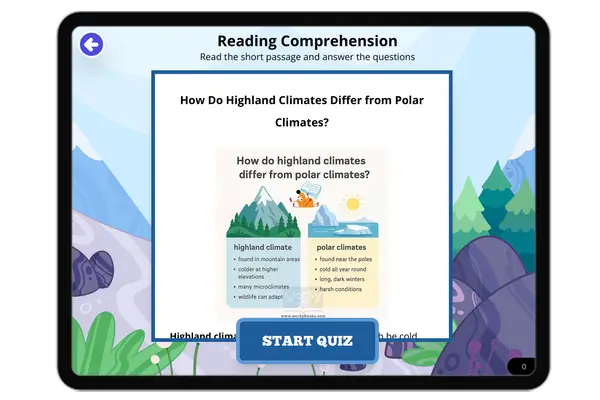Understanding the Köppen Climate Classification System — Passage
The Köppen Climate Classification System is one of the most widely used tools to describe Earth’s different climates. Developed by German scientist Wladimir Köppen in the early 1900s, this system groups the world’s climates based on temperature, rainfall, and seasonal patterns. Scientists, geographers, and meteorologists use it to study weather patterns, ecosystems, and climate change.
The system divides climates into five major categories, each labeled with a capital letter:
● A: Tropical (hot and wet)
● B: Dry (deserts and dry grasslands)
● C: Temperate (mild with seasons)
● D: Continental (cold winters, warm summers)
● E: Polar (very cold all year)
Each category can be broken down into subtypes using additional letters. For example, “Af” means a tropical rainforest climate, where it rains all year and stays warm. “Aw” is a tropical climate with a dry winter. “BS” means a semi-arid climate (like a steppe), and “ET” is a tundra climate found near the poles.
This system is helpful because it shows how climate affects plants, animals, and human life. For example, tropical climates support lush forests and diverse wildlife, while dry climates are home to cacti and animals that can survive with little water. People also build homes, grow food, and dress differently depending on the climate they live in.
The Köppen system helps scientists compare regions, track changes in global temperature, and understand how climate change may shift the boundaries of these zones over time. It is also used in agriculture, education, and environmental planning.
Fun Fact: Some parts of Hawaii, Brazil, and Indonesia all share the same “Af” climate—even though they are on different continents!
Who created the Köppen Climate Classification System?
Charles DarwinIsaac NewtonWladimir KöppenCarl LinnaeusWhat does the “A” category in the Köppen system represent?
Arctic climateDry climateTropical climateMountain climateWhat does “Af” stand for in the Köppen system?
Arctic frostAlpine fallTropical rainforestDesert and forestWhich category describes areas with cold winters and warm summers?
A – TropicalD – ContinentalB – DryE – PolarWhy is the Köppen system useful?
It shows Earth’s gravityIt explains ocean tidesIt helps study and compare climatesIt tracks earthquakesWhat does the second letter in a Köppen code represent?
The month of the yearSoil typeRainfall or temperature detailsAltitudeWhat is the main idea of the passage?
Scientists only study tropical zonesThe Köppen system helps us understand global climatesDeserts are increasing worldwideRainforests are shrinkingIf a region's climate changes from “C” to “B,” what might that mean?
It gets wetter and coolerIt is becoming drierIt is freezing year-roundIt is now near the equator









